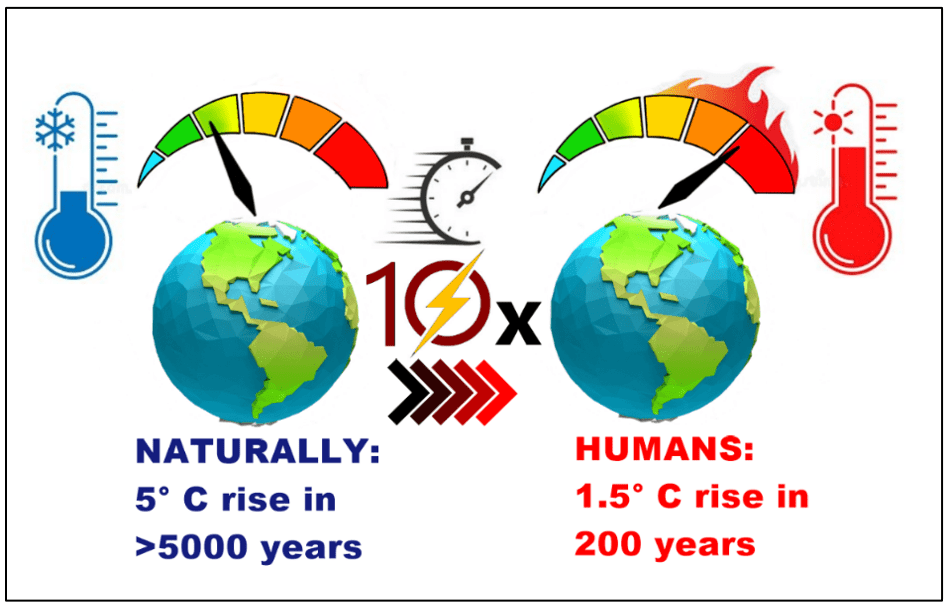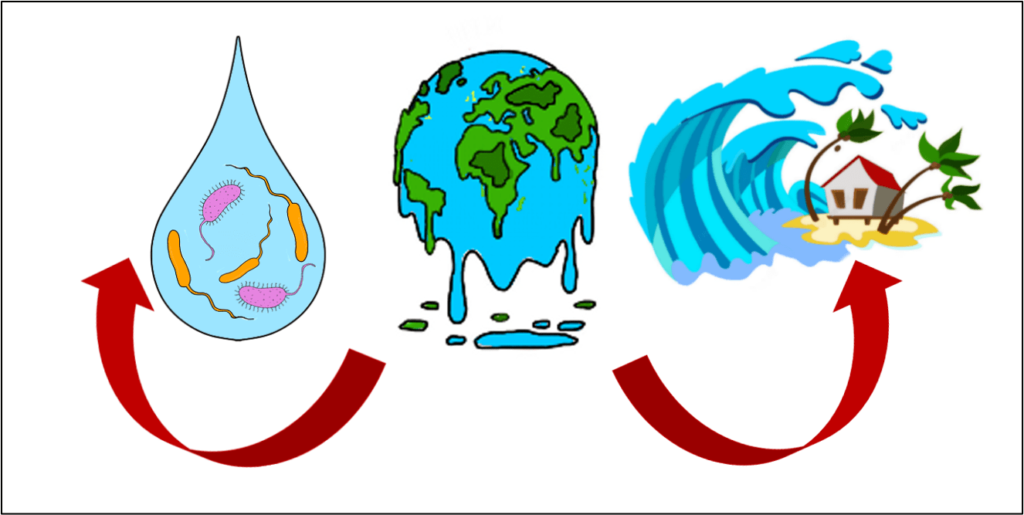In 2022, India faced the hottest April since the last 121 years. A notification popped on my phone’s screen. I blankly nodded as this April was unquestionably hot for me. My mind whispered back to me, “Climate change is real, Apoorva!”. You have read about it in the books, but it is really happening right now.
As stated by the United Nations, climate change refers to long-term shifts in temperatures and weather patterns. These shifts may be natural, but since the 1800s, human activities have been the main driver of climate change, primarily due to the burning of fossil fuels (like coal, oil, and gas), which produces heat-trapping gases.
Paleoclimates (records of Earth’s past climate) were documented by the scientist in an ambitious project, European project for Ice Coring in Antarctica (EPICA). Air trapped within the fallen snow gets encased as tiny bubbles in the ice as the snow gets compressed by weight of later years of snow. These air bubbles in the glaciers provide a sample of Earth’s atmosphere around 800,000 years back. Analysis of the air bubbles revealed that the climate change is normal. Wait, what? Yes, climate change has been happening since Earth was formed and Earth has been naturally warming since then. It sounds so relieving. If it’s a normal process then why is there so much hype about Global warming? The main issue is the speed of warming. It took over 5000 years to hike the Earth’s temperature by 5 degrees. Humans have hastened this rate by 10 times and has resulted in an increase in Earth’s temperature by 1.5 degrees since 1800. Only 200 years.
We check weather reports daily. Weather changes on a daily basis. Seasons occur year round. But the climate is not as moody as the weather. Increased rainfall, melting of glaciers, wildfires, hurricanes, cold spells, droughts, changing precipitation patterns and more extreme weather patterns like Uttarakhand flash floods in 2013 signify climate change. 2022 Assam flood, 2021 Maharashtra flooding are some recent casualties. These climate changes exacerbate existing health threats and create new health concerns. Increased frequency of heat waves worsens the asthma attack and other respiratory diseases.

Altered climate patterns affect life cycles of insects, by earlier and expanded tick activity which results in increased Lyme’s disease numbers. Warmer conditions and increased collection of stagnant water favors breeding of Anopheles and Aedes mosquitoes. They roam beyond their habitats shifting burdens of disease like Malaria, dengue fever, chikungunya leishmaniasis, Japanese Encephalitis and filariasis. India is afflicted by these six major vector borne diseases. Increase in ground level Ozone is detected, inhalation of ozone recedes the lung activity and results in premature death. Besides Ozone black carbon, the most common air pollutant, hampers the healthy lungs. Post flood diversity of diseases is seen with most prevalent being Cholera and rotavirus.
Climate change is a global phenomenon. It affects human health which can be categorized in two ways, direct and indirect. Increasing sea levels, changed precipitation patterns and hurricanes degrade the quality of tap water and water borne diseases like typhoid, cholera occur in affected regions in great numbers. This is a direct effect. On the other hand, demolishment of infrastructure, loss of loved ones in such calamities affects the survivors mental health, resulting in increased cases of post traumatic stress disorder, stress and anxiety. Yearly 12.6 billion people die from avoidable environmental changes.
Why did humanity thrive only on the Earth? Water, Oxygen and climate. Right now the harmony of the climate is disturbed, which is an alarming sign for us. Changed lifestyle, increased health care facilities have caused major impacts on humans adaptability toward pathogens. We are becoming less resilient day by day as compared to our ancestors in terms of strength and immunity. When the monsoon arrives in the Indian continent half of India suffers from cold and cough. This annual change is sufficient to expand our imagination of the impact climate change is having on us. Children, elderly and the population with underlying health conditions are at higher risk than other populations. Especially in developing countries like India. Developing nations are the most vulnerable group for climate change. Climate change damages their economy beyond repair which aggravates the conditions. Raising temperature, changed precipitation patterns affects the production of staple food which results in malnutrition and raises questions on food security of people. Climate change is forcing people to migrate to other places for better food security and better living conditions.
The law of evolution is the fittest survives. As stated by Darwin in his book, The origin of species. And to survive on Earth we have to take the steps right now or humans will become extinct like dinosaurs. For the first time all the nation’s around the world united under one roof and signed a treaty, the Paris agreement. This treaty aims to reduce the Earth’s temperature by 1.5 degrees till 2050. It aims in reducing the Greenhouse gases (GHG) emission which is the chief contributing factor for climate change.
India has laid a strong foundation to pledge with the Paris agreement. Promotion of renewable energy is a strong commitment towards climate change. Reducing GHG emission is the main goal which can be achieved by replacing the use of fossil fuel by newer, efficient energy sources. Development of solar parks, ultra mega solar power projects, promoting the use of clean energy by giving subsidies for electric vehicles, solar power electronic tools, such incentives are taken up by the government.
If everyone pitches in this quest for a better change, we can take the reins of the damage in our hands and successfully reduce the impact of our actions on our Earth.
Reference:
1. https://www.epa.gov/climate-indicators/understandingconnections-between-climate-change-and-humanhealth
2. https://www.niehs.nih.gov/research/programs/climatechange/index.cfm
3. https://www.ncbi.nlm.nih.gov/pmc/articles/PMC3114809/
4. https://www.un.org/en/climatechange/what-is-climate-change
5. https://earthobservatory.nasa.gov/features/GlobalWarming/page3.php
6. https://unfccc.int/process-and-meetings/the-paris-agreement/the-paris-agreement
. . .
Writer
Apoorva Koli
Illustrator
Jayakrishnan Nair
Editor
Bhargavi Nerikar

